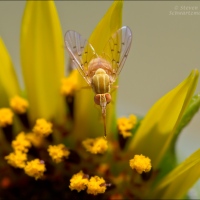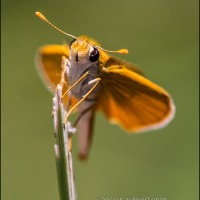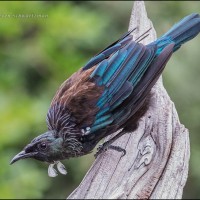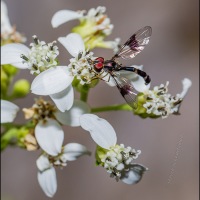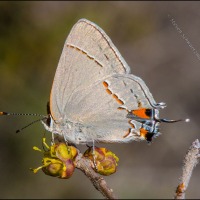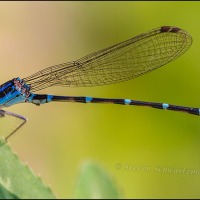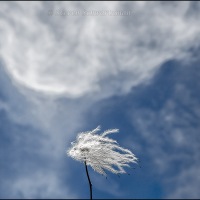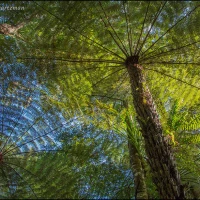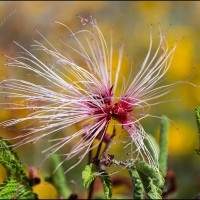Posts Tagged ‘native plants’
A reprise 18 days later
On the morning of December 11th I had my first encounter for this season with frostweed’s ice phenomenon, which you’re welcome to look back at and read an explanation of. Yesterday morning marked my second encounter, which came on a much smaller scale. Where I’d had at least 20 frostweed plants (Verbesina virginica) with good ice formations to choose from the first time, yesterday offered very few active plants, and the ice formations on them were pretty small. Still, it was more than the 38° on our back yard’s outdoor thermometer promised when I checked it early in the morning, so I was glad to find any frostweed ice at all after I drove the half-mile downhill to Great Hills Park and walked down the slope to the frostweed plants I’ve been relying on for years to do their ice trick.
© 2023 Steven Schwartzman
Say, what kind of a joint is this?
Mixed into the starry chaos of asters (Symphyotrichum subulatum) at Barkley Meadows Park
in Del Valle three years ago today were plenty of smartweed plants (Persicaria sp.).
A few of those smartweed plants still had flowers; most, well on their way to
giving up the ghost, were pushing their red stems toward brown as they dried out.
Particularly interesting photographically are these plants’ swollen joints,
of which you’re seeing two. The first is fresher, the second drier.
§
Bet you didn’t know the smart that means ‘to sting, to cause pain’ and the smart that means ‘intelligent’ are essentially the same word. The ’cause pain’ sense is the original one (compare the German cognate Schmerz). As the Online Etymology Dictionary notes, the adjective first meant, in around 1300 and in reference to hits, blows, etc., ‘stinging; causing a sharp pain.’ Later, when applied to speech, the adjective meant ‘harsh, injurious, unpleasant,’ and by the early 1600s the sense had drifted to ‘pert, impudent; on the impertinent side of witty.” From there it wasn’t far to ‘quick, active, intelligent, clever.” Compare the way we similarly describe an intelligent person as sharp.
As for how smartweed got its name, an intelligent answer seems to be that contact with at least one species can cause a person’s skin to smart.
© 2023 Steven Schwartzman
An eerie street lamp
Call it an eerie street lamp if you will. Or imagine a medieval flail. The truth resides elsewhere, in an already withered basket-flower plant (Plectocephalus americanus) whose bud, though still shining, was doomed never to go beyond the stage you see here.
☙
☙ ☙ ☙
☙
In the United States we’ve sunk to a new low with a new high: the national debt is now reported to have risen to $32 trillion. Let me write that out in figures so you see how big it is: $32,000,000,000,000. Here’s another way to look at it: each American’s individual share of that debt is about $95,000. For Americans who actually pay federal income taxes—and 40% of American households don’t—their share of the national debt is about $249,000 apiece. To say that such a huge and still growing debt is fiscally irresponsible and therefore a national disgrace is to say the obvious.
© 2023 Steven Schwartzman
Gestalt
English has borrowed the German word Gestalt, though without the capital letter that German uses on all its nouns (and that English used to). Here’s how the Cambridge Dictionary defines the word as used in English: ‘something such as a structure or experience that, when considered as a whole, has qualities that are more than the total of all its parts.’
I’ve noticed that each plant species has its gestalt, its characteristic way of looking. As an example, take the sand sagebrush, Artemisia filifolia, that drew my attention at the Boca Negra Canyon section of Albuquerque’s Petroglyph National Monument on October 15th. Once you’ve seen sand sagebrush, you’re not in doubt when you see it again.
© 2022 Steven Schwartzman
Native plants at Valley of Fires Recreation Area
While traveling a roundabout way from Las Cruces to Albuquerque on October 12th we visited the Valley of Fires Recreation Area in south-central New Mexico. You might think the extensive lava there would inhibit plant growth, but that’s not the case, as the native plants in this post attest. One goes by a pithy vernacular name, winterfat, but its scientific name is a mouthful: Krascheninnikovia lanata. The species epithet is Latin for ‘woolly’ (Spanish and Italian still have lana for ‘wool’), and these two pictures of the plant show you why that’s an apt description.
Another native plant has the catchy vernacular name four-wing saltbush, Atriplex canescens.
I’m afraid I don’t know what kind of grass had gone to seed to the left of it.
You can get a closer look at saltbush in pictures from our 2014 visit to New Mexico.
And of course various cacti grow in the area, including the cholla (Cylindropuntia sp.) below.
Its upper portions may (or may not) have been dead.
The green branches closer to the ground unambiguously attest to life.
© 2022 Steven Schwartzman
Valley of Fires Recreation Area
Obsession, foolishness, pertinacity, stubbornness, dedication: take your pick. WordPress tells me that as of today I’ve put out 4000 posts. That’s enough posts to build a gigantic wooden fortress.
Instead of doing that I’ll show you where we stopped on October 13th after we continued north from the Three Rivers Petroglyph Site. As enchanted as I’d been by the Valley of Fire State Park during our 2016 visit to Nevada, how could I not stop at New Mexico’s Valley of Fires Recreation Area? The “Fires” in New Mexico are a reference to vulcanism, as you see in the top picture, which is an overview, and the next photograph, which offers a closer look at a congealed lava flow.
And here’s an upward look at a lava formation several meters high:
© 2022 Steven Schwartzman
Snow-on-the-prairie revisited
In a post last month you saw the snow-on-the-prairie plant (Euphorbia bicolor) I’d gotten low to photograph against a cloudy sky on September 3rd at the Wildhorse Ranch subdivision in Manor. On October 2nd I went back there and ended up photographing a different snow-on-the-prairie plant. The sky was bluer and the clouds fleecier than a month earlier, so the overall effect was quite different.
Because the clouds were so appealing I took dozens of pictures of them in their own right. Stieglitz called his cloud portraits “equivalents.” I’ll call mine “cloudtraits.” In the one below, I took the rare (for me) step of converting to black and white.
§
§ § §
§
In some of my commentaries I’ve complained about how poorly the American education “system” educates America’s children. On October 4th, the editorial board of the Wall Street Journal focused on the state of Illinois:
Statewide, in 2019, 36% of all third grade students could read at grade level. That’s an F, and that’s the good news. That number drops to 27% for Hispanic students and 22% for black students statewide. In certain public school systems, the numbers plummet to single digits. In Decatur, 2% of black third-graders are reading at grade level and only 1% are doing math at grade level.
We aren’t often speechless, but the extent to which that performance is betraying a generation of schoolchildren is hard to put into words. Third grade children are eight years old, full of potential with minds like sponges to absorb what they are taught. Third grade is the year that children need to achieve a level of reading fluency that will prepare them to tackle more complex tasks in upper elementary grades that require comprehension.
A child who can’t read in third grade can’t do word problems in fourth or science experiments in fifth. Promoting Decatur children to the fourth grade when 99% are below grade level in math condemns them to future failure. By 11th grade, 5% of Decatur’s students are reading at grade level and 4% are on par in math. Why shouldn’t every single adult presiding over the Decatur schools be fired?
Why indeed? You can read the full editorial.
© 2022 Steven Schwartzman
Cattails releasing seeds
When I spent time at Round Rock’s Meadow Lake Park on August 24th I was happy to find that some of the cattails (Typha sp.) were shedding their numerous seeds. In the view above, the arcs of drying cattail leaves made the scene even more attractive to me. The slender green plants mixed in among the cattails are Symphyotrichum subulatum, known as baby’s breath aster, annual aster, eastern annual saltmarsh aster, Blackland aster, wireweed and hierba del marrano (which we might translate as pigweed).
The second picture shows something I don’t recall ever seeing before. My first thought was that this cattail stalk had split in an early stage of development and each piece went on to produce seeds. Now I’m wondering if the hanging piece might have broken off from the far side of the main seed head, though I think I looked at this from different positions and would have noticed such an obviously missing chunk. Mysteries.

✦
✦ ✦ ✦
✦
On August 24th Quillette published “The Energy of Nations” by John Constable and Debora Lieberman. The first two words in the article’s subtitle, “Energy blindness is leading to policy blunder,” refer to the fact that many people don’t understand what energy is:
Indeed, we hold surprisingly few scientifically accurate cognitive intuitions to guide decisions about the character of energy and its importance. Without science, we are more or less energy blind, in the same way, perhaps, that fish are blind to the idea of water. This is to be expected, perhaps, since the concept of energy was a recent development in science, dating only from the early to mid-19th century. And part of the problem we have in understanding this concept is that it is extremely abstract. Energy isn’t a substance like coal or oil; rather, it is an abstract property of all substances, namely the capacity to cause change in the world—to do work, a potential measured in joules.
The next paragraphs make an important point:
Joules can be realised as a property of the chemical bonds in fossil fuels, the forces holding an atom together, moving objects such as flowing wind or water, electromagnetic solar radiation, and objects acting on each other through gravity. All have the capacity to cause change, but this capacity varies in both quantity, which is intuitively obvious, and much more importantly, its quality, its ability to do work, to change the world, and here the mind is particularly weak in grasping the essentials. Yes, there is a large quantity of energy in the sunshine and in the wind blowing around the globe. But that energy is of very low quality and not available to do much useful work. There is also a great deal of energy in the vibrating atoms in the objects around you in the room as you read this article, or in falling raindrops—lots of energy, yet all basically useless. Wind and sunlight are only a little better. There is a reason why no creatures make a living by extracting energy from the wind—the quality level is just too low—and there is a reason that the organisms that manage to build lives from solar energy, plants, are relatively simple and, generally speaking, stationary. There is only so much you can do with a low-quality form of energy like solar radiation at the surface of the Earth. Creatures that eat plants can be more complex; creatures that eat herbivores can be more complex still.
The science of thermodynamics tells us that for a fuel to have high value to us, what matters is the quality, and that the fuel must have a very low degree of disorder (low entropy) if it is to support a complex society such as our own. But we have few intuitions of this, and our energy blindness requires us to rely on evidence and reason to tell us that fossil fuels are of high thermodynamic quality, as is fissile uranium. By comparison, the plentiful energy of renewables such as wind and solar is of low quality. In fact, both wind and solar radiation are so disordered that their entropy is close to that of low-temperature random heat, that is, the random movement of atoms and molecules. Their potential to do work—to cause change—is very limited.
Moreover, transforming sunlight and wind into grid electricity requires turbines and photovoltaic panels, themselves complex and expensive states of matter, as well as any number of ingenious and expensive grid kludges such as batteries to render it useable. That makes renewable energy intrinsically expensive. The sunshine and wind might be free, but not the extraction, conversion, and stable delivery to market.
You’re welcome to read the full article for more details. And you can find out a whole lot more in Alex Epstein’s book Fossil Future, which I finished reading a couple of weeks ago.
© 2022 Steven Schwartzman
The colors said fall; the calendar said otherwise.
As hardy as poison ivy (Toxicodendron radicans) is, this hueful plant was feeling the effects of two months without rain when I photographed it along Bull Creek on August 17th. People who’ve had patches of skin turn these colors from contact with poison ivy may be less sanguine about the sight than a disinterested nature photographer who’s never had that experience and who values a picture for esthetic reasons.
✦
✦ ✦ ✦
✦
If you spun a coin 10 times in a row and it came to rest tails all 10 of those times, would you draw any conclusions? You might be suspicious and think you’ve got an unevenly balanced coin that’s weighted toward one side. On the other hand, if you spin even a perfectly balanced coin 10 times in a row over and over and over for zillions of trial runs, simple arithmetic tells us to expect that on average the coin will come up tails 10 times in a row once out of every 1024 trial runs. One out of 1024 is a small number, roughly one-tenth of one percent, but it isn’t zero. Uncommon things do occasionally happen.
Where the human realm intersects the realm of probability, things can get contentious. For example, the American IRS (Internal Revenue Service) legitimately scrutinizes applications from organizations requesting tax-exempt status to make sure those organizations comply with the regulations required of tax-exempt entities. Suppose that over a certain period of time the IRS gives extra scrutiny to hundreds of tax-exempt or would-be tax-exempt organizations that lean in one political direction but to only a handful of organizations that lean in the opposite political direction. Of course that imbalance could have happened just by chance, but people who lean in the way-more-scrutinized political direction would probably suspect that the highly unbalanced scrutiny is intentional rather than random.
Sometimes that kind of suspicion has proven justified. You may recall this item from 2013:
The Internal Revenue Service is apologizing for inappropriately flagging conservative political groups for additional reviews during the 2012 election to see if they were violating their tax-exempt status.
Lois Lerner, who heads the IRS unit that oversees tax-exempt groups, said organizations that included the words “tea party” or “patriot” in their applications for tax-exempt status were singled out for additional reviews.
Lerner said the practice, initiated by low-level workers in Cincinnati, was wrong and she apologized while speaking at a conference in Washington.
The illegally discriminated-against groups sued and eventually received a financial settlement from the government (which unfortunately means that we the taxpayers paid for the politically motivated misdeeds of some people at the IRS).
You may say that’s old news, which it is. I bring it up, however, because I just came across an article that once again raises doubts about the fairness of our government bureaucracies. You’ll recall that two years ago the U.S. government carried out its once-every-decade census of the population. The results of the census determine, among other things, how many seats in the House of Representatives each state gets. Based on the 2020 census, 7 states lost one House seat apiece; 5 states gained one seat apiece; 1 state (yay, Texas!) even gained two seats.
With that in mind, look how the August 22nd article by Hans von Spakovsky begins:
In a shocking report, the U.S. Census Bureau recently admitted that it overcounted the populations of eight states and undercounted the populations of six states in the 2020 census.
All but one of the states overcounted is a blue [liberal] state, and all but one of the undercounted states is red [conservative].
Those costly errors will distort congressional representation and the Electoral College. It means that when the Census Bureau reapportioned the House of Representatives, Florida was cheated out of two additional seats it should have gotten; Texas missed out on another seat; Minnesota and Rhode Island each kept a representative they shouldn’t have; and Colorado was awarded a new member of the House it didn’t deserve.
So 14 states were incorrectly counted, and in 12 of the 14 cases the result favored the same political party. Could that heavy imbalance have happened merely by chance? Yes, it could have. But the political party that got by far the greatest advantage from the incorrect census counting is the same party that benefited from the illegal IRS over-scrutiny in the previous decade. That understandably raises suspicions among those who are, in the words of an adage, “once bitten, twice shy.”
© 2022 Steven Schwartzman






















